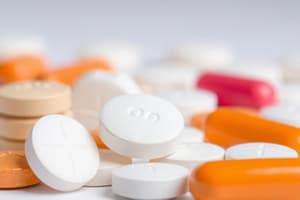Podcast
Questions and Answers
Which of the following best describes the term 'pharmacopoeia'?
Which of the following best describes the term 'pharmacopoeia'?
- A method of tablet administration.
- A type of pharmaceutical drug.
- A book containing directions for the identification of compound medicines. (correct)
- A type of pharmaceutical excipient.
What is a tablet?
What is a tablet?
A solid dosage form containing one or more active ingredients produced by compressing uniform volumes of granules.
What is an active pharmaceutical ingredient (API)?
What is an active pharmaceutical ingredient (API)?
A chemical substance used to treat, cure, prevent, or diagnose a disease or to promote well-being.
Excipients are substances that are active themselves.
Excipients are substances that are active themselves.
A tablet can be administered by being swallowed, chewed, or dissolved in water.
A tablet can be administered by being swallowed, chewed, or dissolved in water.
Which of the following are considered quality attributes of tablets? (Select all that apply)
Which of the following are considered quality attributes of tablets? (Select all that apply)
What is the role of a disintegrant in tablet formulation?
What is the role of a disintegrant in tablet formulation?
The process by which a solid substance enters a solvent to yield a solution is called ________.
The process by which a solid substance enters a solvent to yield a solution is called ________.
Which type of excipient reduces the adhesion of powder in tablet formulations?
Which type of excipient reduces the adhesion of powder in tablet formulations?
What is the function of a binder in tablet formulation?
What is the function of a binder in tablet formulation?
Lubricants are added to tablets to increase the friction between the tablet surface and die walls.
Lubricants are added to tablets to increase the friction between the tablet surface and die walls.
Flashcards are hidden until you start studying
Study Notes
Overview of Tablets
- Tablets are solid dosage forms containing one or more active ingredients, produced by compressing granules.
- Pharmacopoeia originates from Greek, translating to a book containing directions for identifying compounded medicines and published by authoritative bodies.
Drug Components
- Active Pharmaceutical Ingredient (API): Chemical substance used for treatment, prevention, diagnosis, or promoting well-being.
- Excipients: Inactive substances that support the drug’s delivery without having a therapeutic effect, enhancing the drug's functionality.
Administration Methods
- Tablets can be administered whole, chewed, dissolved in water, or retained in the mouth.
- Oral route is preferred due to convenience, safety, stability compared to liquids, and accurate dosing.
Quality Attributes of Tablets
- Correct dosage of the drug must be ensured.
- Consistency in weight, size and appearance is essential.
- Controlled and reproducible drug release is required.
- Tablets should have mechanical strength to withstand physical handling.
- Stability in chemical, physical, and microbiological properties is necessary.
- Safe packaging is critical for protecting contents.
Types of Tablet Excipients
- Diluents/Fillers: Increase tablet size and powder volume. Must be chemically inert, non-hygroscopic, hydrophilic, inexpensive, and acceptable in taste (e.g., lactose, cellulose derivatives).
- Disintegrants: Facilitate the breakdown of tablets into granules, ensuring active ingredient release.
Disintegration Mechanisms
- Capillary Action: Liquid penetrates the tablet, weakening intermolecular bonds.
- Swelling: Disintegrants absorb water, causing physical expansion and rupture of the tablet.
- Gas Release: Ingredients release gas upon contact with water, aiding disintegration (e.g., bicarbonates with citric acid).
Binder Functions
- Binders ensure the mechanical strength of tablets and promote cohesiveness by agglomerating powder into granules.
- Can form intergranular bonds during compression, maintaining tablet integrity.
Glidants
- Added to powders for improved flowability, ensuring consistent tablet weight and shape during manufacturing.
Lubricants
- Facilitate smooth tablet surfaces by reducing friction between the tablet and die walls.
- Essential for ensuring proper ejection of the tablet but should be used within recommended limits to avoid compromising tablet strength.
Other Excipients
- Antiadherents: Reduce powder adhesion to equipment during tablet formation (e.g., talc, magnesium stearate).
- Sorbents: Absorb moisture, allowing incorporation of oily solutions into tablet mixtures (e.g., microcrystalline cellulose).
- Colorants: Enhance tablet appearance for identification and patient compliance.
- Flavoring Agents: Mask unpleasant tastes, particularly for pediatric formulations (e.g., for chewable tablets).
Conclusion
- Tablets are a vital pharmaceutical dosage form, combining various components to ensure efficacy, safety, and patient compliance in medication delivery.
Studying That Suits You
Use AI to generate personalized quizzes and flashcards to suit your learning preferences.



